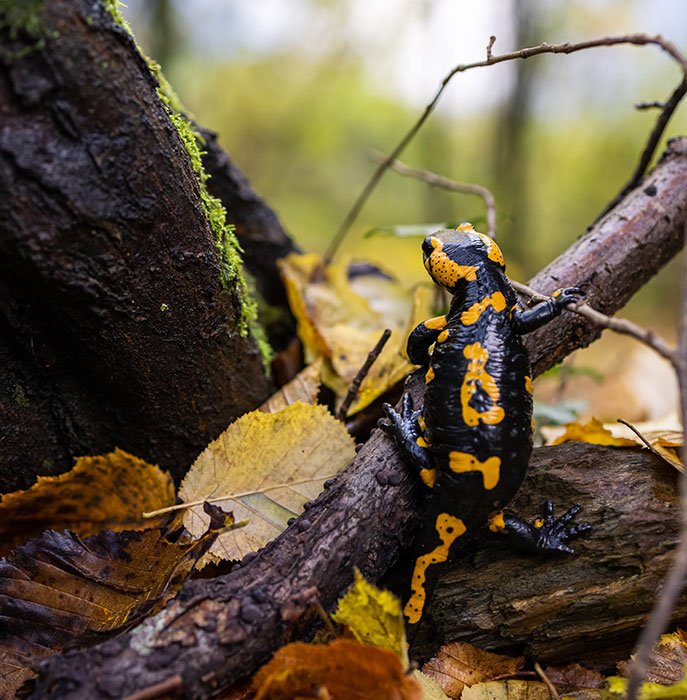Why Did the Salamander Cross the Road?
Created Creature
by Samantha Roth on September 24, 2023Watch your step when you’re crossing the street. There might be a salamander on the road. Wait, on the road?
On rainy October days in the eastern and central United States, tiger salamanders leave fields and ditches and walk back to the wetlands where they were born. That’s a long walk for a creature barely bigger than your hand!
Why do tiger salamanders go to the wetlands in the first place? Even though fields and ditches are great places to find food, they’re not the right environment for salamanders during the winter. God designed salamanders with the instinct to migrate to the wetlands where they can stay safe and cozy.
A Long Winter’s Nap
Salamanders are amphibians. Most amphibians can live both on land and in water but need to keep their skin wet to stay healthy. The ground in the wetlands is soft enough for tiger salamanders to burrow beneath the frostline, the top layer of the ground that freezes in the winter. Underground, tiger salamanders can stay safe and damp until spring comes.
Tiger salamanders spend the summer months in fields and ditches eating mice and insects to build up fat. This sustains them during the winter. They sleep through most of the winter in a state called brumation (broo-MAY-shun). Unlike animals that sleep all winter in hibernation, salamanders sleep or wake up depending on the temperature. During brumation, salamanders don’t eat or drink, and their heart rate slows down. While they can still move, they are much slower than usual.
Now You See Me, Now You Don’t!
Tiger salamanders go great and dangerous distances to return to the wetlands. Your parents might hold your hand when you cross the street, but the slow-moving salamanders cross the road all by themselves. Thanks to God’s design, tiger salamanders can avoid being seen by predators when they’re out on the open road.
The pattern on the tiger salamander’s body provides camouflage, allowing this little creature to blend in with its environment. This makes it almost impossible for a predator, such as a snake or bird, to spot the tiger salamander when it’s not moving. As a result of Adam and Eve’s sin, death entered the world, and now animals hunt each other. The camouflage that God gave some creatures helps keep them safe.
But that’s not the only way the tiger salamander stays safe. When it feels threatened by a predator, it can lose its tail. The tail distracts the predator by wiggling around, giving the salamander time to escape. The salamander can grow a new tail to replace the one it lost (a process called regeneration).

Fun Facts
- Tiger salamanders try to make themselves look bigger by holding their tail up and arching their back when they feel threatened.
- Tiger salamanders will eat just about anything that will fit in their toothless mouths.
- Tiger salamanders can live to be 20 years old.
- Most tiger salamanders have spots.
- Sometimes tiger salamanders move into burrows that other animals have dug.
Living Life Salamander Style
While in the wetlands, tiger salamanders breed and lay eggs. As babies, most amphibians don’t look anything like their parents. After hatching, many amphibians go through a big transformation called metamorphosis. This is when most baby salamanders grow legs and other features. While most full-grown tiger salamanders are 6–8 inches long, some can grow up to 13 inches—that’s longer than a foot-long sub sandwich!
Baby tiger salamanders are aquatic—they live in the water. As adults, most salamanders can live in water and on land. Wetlands, marshy areas, and ponds are perfect places for them to call home for most of the year.
Wherever the ground is soft enough, tiger salamanders love to dig. They make their own burrows that protect them from extreme heat and cold. They come out of their burrows at night to eat insects and small animals, including earthworms.
Searching for Salamanders
- Head out to a marshy area on a rainy day. It’s easiest to find tiger salamanders when they are crossing roads and sidewalks.
- When you find a tiger salamander, be very gentle—salamanders are delicate. Make sure your hands are damp and free of any chemicals (like hand sanitizer) before petting or holding a salamander.
- Remember to leave the salamander where you found it.
Tiny Travelers
Tiger salamanders go on a big journey every fall to return to the places where they were born. These salamanders might be small, but they are a huge testimony to the way God cares for his creation
!Kids Answers Magazine
Your Terrific Tongue
Talking, tasting, swallowing, even whistling—your tongue does amazing things every day.
Browse Kids Issue- © 2025 Answers in Genesis
- Privacy Policy
- Contact
- About

